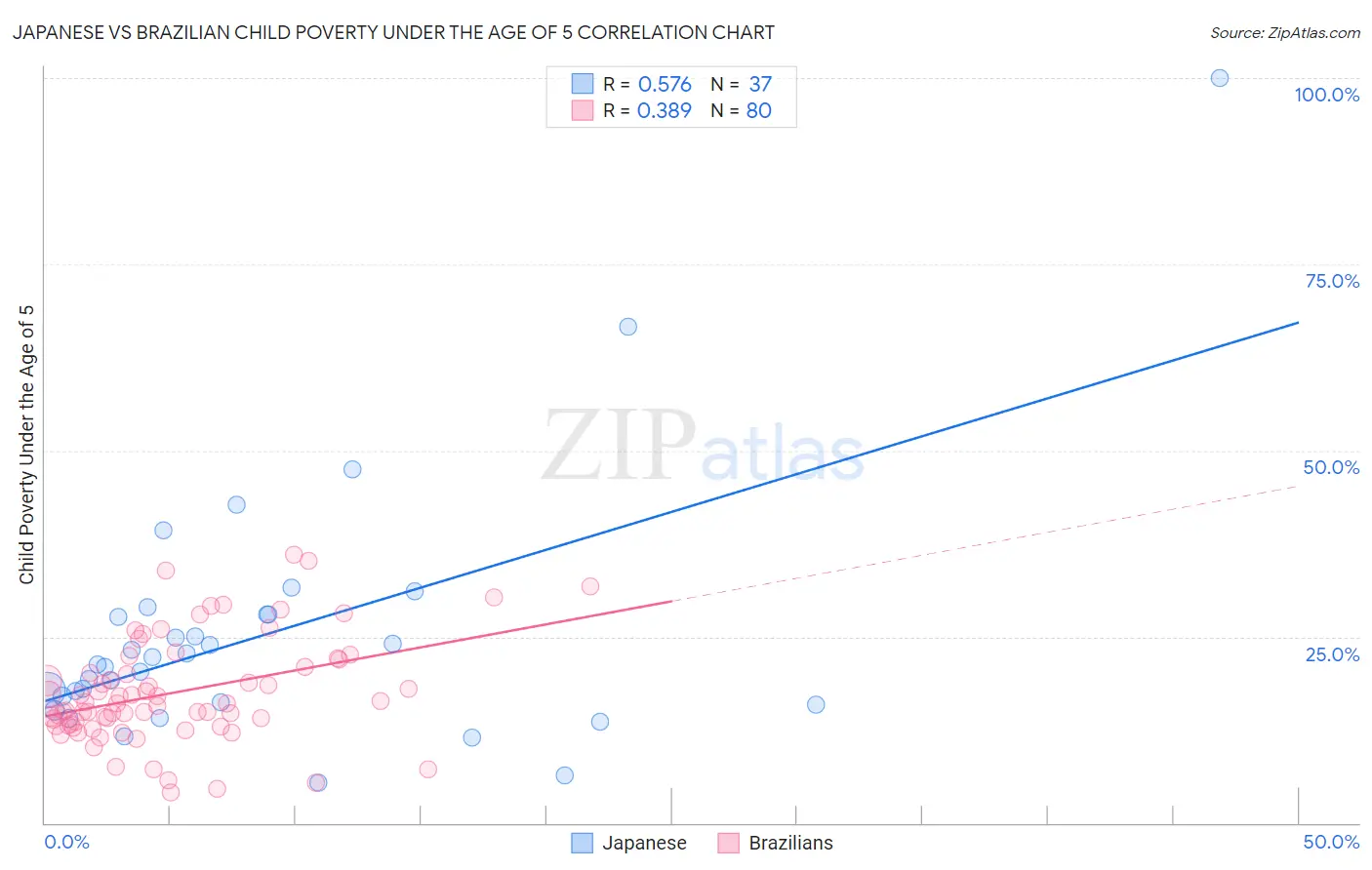Japanese vs Brazilian Child Poverty Under the Age of 5
COMPARE
Japanese
Brazilian
Child Poverty Under the Age of 5
Child Poverty Under the Age of 5 Comparison
Japanese
Brazilians
18.1%
CHILD POVERTY UNDER THE AGE OF 5
13.8/ 100
METRIC RATING
202nd/ 347
METRIC RANK
16.4%
CHILD POVERTY UNDER THE AGE OF 5
87.8/ 100
METRIC RATING
135th/ 347
METRIC RANK
Japanese vs Brazilian Child Poverty Under the Age of 5 Correlation Chart
The statistical analysis conducted on geographies consisting of 243,928,105 people shows a substantial positive correlation between the proportion of Japanese and poverty level among children under the age of 5 in the United States with a correlation coefficient (R) of 0.576 and weighted average of 18.1%. Similarly, the statistical analysis conducted on geographies consisting of 312,012,194 people shows a mild positive correlation between the proportion of Brazilians and poverty level among children under the age of 5 in the United States with a correlation coefficient (R) of 0.389 and weighted average of 16.4%, a difference of 10.4%.

Child Poverty Under the Age of 5 Correlation Summary
| Measurement | Japanese | Brazilian |
| Minimum | 5.4% | 4.1% |
| Maximum | 100.0% | 36.1% |
| Range | 94.6% | 31.9% |
| Mean | 25.2% | 17.5% |
| Median | 21.3% | 16.1% |
| Interquartile 25% (IQ1) | 16.0% | 13.2% |
| Interquartile 75% (IQ3) | 28.1% | 21.5% |
| Interquartile Range (IQR) | 12.0% | 8.2% |
| Standard Deviation (Sample) | 17.1% | 7.0% |
| Standard Deviation (Population) | 16.9% | 7.0% |
Similar Demographics by Child Poverty Under the Age of 5
Demographics Similar to Japanese by Child Poverty Under the Age of 5
In terms of child poverty under the age of 5, the demographic groups most similar to Japanese are Ugandan (18.0%, a difference of 0.020%), Immigrants from Cambodia (18.1%, a difference of 0.020%), Iraqi (18.0%, a difference of 0.030%), Immigrants from Eastern Africa (18.1%, a difference of 0.080%), and Spaniard (18.1%, a difference of 0.21%).
| Demographics | Rating | Rank | Child Poverty Under the Age of 5 |
| Sierra Leoneans | 24.1 /100 | #195 | Fair 17.7% |
| Immigrants | Portugal | 22.2 /100 | #196 | Fair 17.8% |
| Immigrants | Kenya | 20.0 /100 | #197 | Fair 17.9% |
| Celtics | 18.3 /100 | #198 | Poor 17.9% |
| Hungarians | 18.3 /100 | #199 | Poor 17.9% |
| Iraqis | 14.0 /100 | #200 | Poor 18.0% |
| Ugandans | 13.9 /100 | #201 | Poor 18.0% |
| Japanese | 13.8 /100 | #202 | Poor 18.1% |
| Immigrants | Cambodia | 13.7 /100 | #203 | Poor 18.1% |
| Immigrants | Eastern Africa | 13.4 /100 | #204 | Poor 18.1% |
| Spaniards | 12.8 /100 | #205 | Poor 18.1% |
| Whites/Caucasians | 12.6 /100 | #206 | Poor 18.1% |
| Immigrants | Immigrants | 9.9 /100 | #207 | Tragic 18.2% |
| Scotch-Irish | 9.8 /100 | #208 | Tragic 18.2% |
| Spanish | 9.8 /100 | #209 | Tragic 18.2% |
Demographics Similar to Brazilians by Child Poverty Under the Age of 5
In terms of child poverty under the age of 5, the demographic groups most similar to Brazilians are Immigrants from North Macedonia (16.4%, a difference of 0.010%), Icelander (16.3%, a difference of 0.030%), Immigrants from Northern Africa (16.4%, a difference of 0.060%), Serbian (16.3%, a difference of 0.10%), and Finnish (16.3%, a difference of 0.13%).
| Demographics | Rating | Rank | Child Poverty Under the Age of 5 |
| South Africans | 90.1 /100 | #128 | Exceptional 16.2% |
| British | 89.4 /100 | #129 | Excellent 16.3% |
| Immigrants | Norway | 89.3 /100 | #130 | Excellent 16.3% |
| Finns | 88.3 /100 | #131 | Excellent 16.3% |
| Serbians | 88.2 /100 | #132 | Excellent 16.3% |
| Icelanders | 87.9 /100 | #133 | Excellent 16.3% |
| Immigrants | North Macedonia | 87.8 /100 | #134 | Excellent 16.4% |
| Brazilians | 87.8 /100 | #135 | Excellent 16.4% |
| Immigrants | Northern Africa | 87.5 /100 | #136 | Excellent 16.4% |
| Immigrants | Chile | 85.3 /100 | #137 | Excellent 16.4% |
| Germans | 84.8 /100 | #138 | Excellent 16.5% |
| Immigrants | Hungary | 84.5 /100 | #139 | Excellent 16.5% |
| Guamanians/Chamorros | 84.2 /100 | #140 | Excellent 16.5% |
| Immigrants | Western Europe | 83.3 /100 | #141 | Excellent 16.5% |
| Portuguese | 83.0 /100 | #142 | Excellent 16.5% |